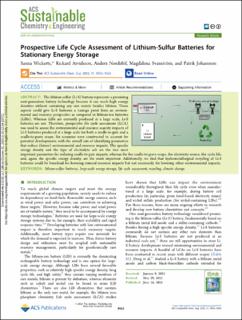| dc.contributor.author | Wickerts, Sanna | |
| dc.contributor.author | Arvidsson, Rickard | |
| dc.contributor.author | Nordelöf, Anders | |
| dc.contributor.author | Svanström, Magdalena | |
| dc.contributor.author | Johansson, Patrik | |
| dc.coverage.spatial | Sweden, Norway, France | en_US |
| dc.date.accessioned | 2024-01-30T14:52:10Z | |
| dc.date.available | 2024-01-30T14:52:10Z | |
| dc.date.created | 2023-09-19T14:57:37Z | |
| dc.date.issued | 2023-06-16 | |
| dc.identifier.citation | ACS Sustainable Chemistry and Engineering. 2023, 11 (26), 9553-9563. | en_US |
| dc.identifier.issn | 2168-0485 | |
| dc.identifier.uri | https://hdl.handle.net/11250/3114617 | |
| dc.description | Sanna Wickerts, Rickard Arvidsson, Anders Nordelöf, Magdalena Svanström, and Patrik Johansson, Prospective Life Cycle Assessment of Lithium-Sulfur Batteries for Stationary Energy Storage, ACS Sustainable Chemistry & Engineering 2023 11 (26), 9553-9563, DOI: 10.1021/acssuschemeng.3c00141 | en_US |
| dc.description.abstract | The lithium-sulfur (Li-S) battery represents a promising next-generation battery technology because it can reach high energy densities without containing any rare metals besides lithium. These aspects could give Li-S batteries a vantage point from an environmental and resource perspective as compared to lithium-ion batteries (LIBs). Whereas LIBs are currently produced at a large scale, Li-S batteries are not. Therefore, prospective life cycle assessment (LCA) was used to assess the environmental and resource scarcity impacts of Li-S batteries produced at a large scale for both a cradle-to-gate and a cradle-to-grave scope. Six scenarios were constructed to account for potential developments, with the overall aim of identifying parameters that reduce (future) environmental and resource impacts. The specific energy density and the type of electrolyte salt are the two most important parameters for reducing cradle-to-gate impacts, whereas for the cradle-to-grave scope, the electricity source, the cycle life, and, again, the specific energy density, are the most important. Additionally, we find that hydrometallurgical recycling of Li-S batteries could be beneficial for lowering mineral resource impacts but not necessarily for lowering other environmental impacts. | en_US |
| dc.description.sponsorship | We would like to thank the Swedish Energy Agency (grant number 50099-1) and the Vinnova competence center Batteries Sweden (BASE) for financially supporting this study. | en_US |
| dc.language.iso | eng | en_US |
| dc.publisher | American Chemical Society | en_US |
| dc.rights | Navngivelse 4.0 Internasjonal | * |
| dc.rights.uri | http://creativecommons.org/licenses/by/4.0/deed.no | * |
| dc.subject | lithium-sulfur batteries | en_US |
| dc.subject | large-scale energy storage | en_US |
| dc.subject | life cycle assessment | en_US |
| dc.subject | recycling | en_US |
| dc.subject | climate change | en_US |
| dc.title | Prospective Life Cycle Assessment of Lithium-Sulfur Batteries for Stationary Energy Storage | en_US |
| dc.title.alternative | Prospective Life Cycle Assessment of Lithium-Sulfur Batteries for Stationary Energy Storage | en_US |
| dc.type | Journal article | en_US |
| dc.type | Peer reviewed | en_US |
| dc.rights.holder | © 2023 The Authors | en_US |
| dc.description.version | publishedVersion | en_US |
| cristin.ispublished | true | |
| cristin.fulltext | original | |
| cristin.qualitycode | 1 | |
| dc.identifier.doi | 10.1021/acssuschemeng.3c00141 | |
| dc.identifier.cristin | 2176589 | |
| dc.source.journal | ACS Sustainable Chemistry and Engineering | en_US |
| dc.source.volume | 11 | en_US |
| dc.source.issue | 26 | en_US |
| dc.source.pagenumber | 9553-9563 | en_US |

